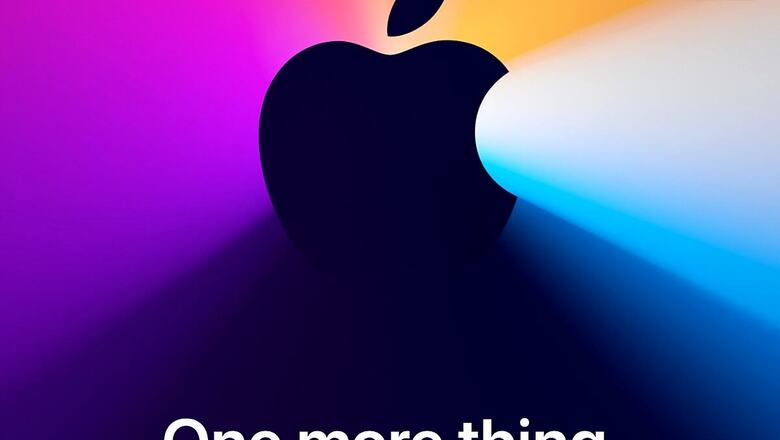
views
We are getting ever closer to the beginning of the end of Apple and Intel’s partnership that has seen off the test of time for a solid 15 years. But not anymore, it seems. As Apple rolls out the invites for what it calls the “One More Thing” Apple Event for November 10, it really isn’t hard to imagine that on the menu will be the much-awaited new Apple Mac computing devices, powered by Apple’s own processors and graphics. There had been whispers about this impending switch since the beginning of the year (you know, the internet can be quite gossipy) and Apple eventually confirmed the switch at the Worldwide Developers Conference over the summer. The colorful invite doesn’t really reveal much, which further begs the question—which Macs get the Apple Silicon first?
First and foremost, it is important to understand that Apple and Intel’s long-standing partnership doesn’t come to an end today. It doesn’t come to an end here and now, or on November 10. This is supposed to be a 2-year transition period, allowing Apple a 24-month window to make the switch for all Mac computing device lines. Yes, you will continue to see new Apple MacBook and Apple iMac updates for at least the next 12 months or so, still running Intel processors. As existing consumers, you need not worry at all about this possible change. Your Macs will continue to get all the updates and support for the next few years, without any change. If you are looking to buy a Mac device now, and the one you have shortlisted happens to be an Intel processor powered one, you can be assured there isn’t a hidden kill-switch that’ll usher in the end of the machine one fine morning. It won’t. Even if Apple and Intel eventually stop making new computing devices together, your Macs will continue to run as they always have.
First and foremost, the Apple Silicon hardware is a very important part of the puzzle for Apple. The same puzzle, the same pursuit to have the same experiential control over the hardware and the software, which has worked wonders for the iPhone line-up over the years. It is expected that the new chip will be very similar to the A14 Bionic that powered the latest iPhone 12 line-up as well as the new Apple iPad Air. With their own processor and graphics, Apple will have complete control over the melding of the hardware, macOS and apps running on the platform, to eke out better performance and a slicker experience. Surely, one of the complaints that Apple must have had with Intel over the past few years would have been that the performance increments on an annual basis just aren’t big enough.
Then there is the cross platform play that Apple wants to leverage. During the WWDC keynote this summer, Apple confirmed that the custom-chips for the Macs will be able to run iPhone and iPad apps too. That will be massive. The underlying architecture of Apple’s A12Z chip (we did not have the A14 Bionic till then) also powers the 2020 versions of the iPad Pro 12.9 and the iPad Pro 11, that has been shipped with the Developer Transition Kit. This includes a Mac Mini with 16GB RAM and a 512GB SSD with the macOS Big Sur developer beta, and the chips that power the iPhone and the iPad remains the same. Apple’s custom chips will have their own designed graphics and storage controllers as well. During the keynote, Apple demoed the power of the upcoming custom-chip powered Macs by also showing off the Monument Valley 2, Calm, and the Fender Play apps. We are finally entering the uniform world that Apple had envisioned with apps running seamlessly across all their platforms. Buy an app on an iPhone, use it on the iPad and macOS as well. That’s the world we are getting ever closer to.
This coming together of macOS with iOS and iPadOS started last year with macOS 10.15 Catalina and the Catalyst apps that support Apple’s UIKit software framework used for the iPhone and iPad apps. It may have been a bit more complicated then, but the change in the beating heart that is the silicon, just streamlines the attempts at uniformity further. If you look at the visual changes that Apple showed off with the upcoming macOS Big Sur, there seems to be a considerable resemblance to the iOS and iPadOS apps for the same—Safari, Messages and Photos, for instance.
So, which Macs will get the first bite of the new silicon? If we are to look at the candidates, it isn’t a simple pick. Unless there is going to be a significant shortening of the update cycle for this year, for some Mac devices.
The Apple MacBook Pro 13 has already received the 2020 refresh with the 10th generation Intel Core processors. So has the MacBook Air, around the same time. The iMac 21.5-inch as well as the iMac 27-inch have also been refreshed in the second half of 2020. That pretty well just leaves the Apple MacBook Pro 16 which is yet to get the 2020 refresh. Could we see the flagship MacBook Pro usher in the Apple Silicon era? It could be a rather solid statement if Apple was to do that. My bets are solidly behind the largest MacBook Pro ushering in the new era for Apple Silicon. Could it also be the Mac Pro that gets the Apple Silicon? It is believed that Apple is working on a redesigned Mac Pro. Yet, it is unlikely that a Mac Pro would be the only Mac to get the Apple Silicon. Well, there has been chatter about the return of the 12-inch Apple MacBook. The MacBook Air and the iPad Pro 12.9 may have something to say about that.
Constituency-Wise Election Results LIVE: West Bengal | Tamil Nadu | Kerala | Assam | Puducherry
LIVE Blogs: West Bengal | Tamil Nadu | Kerala | Assam


















Comments
0 comment